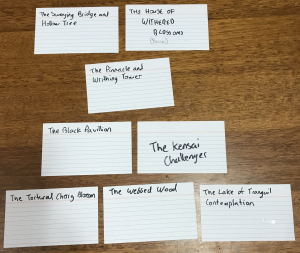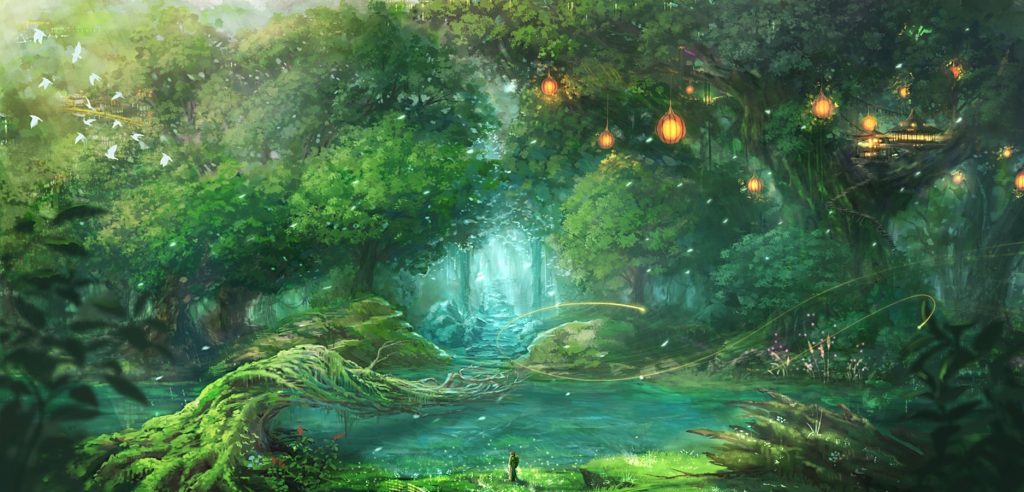I took the cut content from Forest of Spirits and updated it for 5e and used it as part of the overall adventure. I used cards to navigate the garden itself instead of mapping it out – just abstracted it away. I had a minimum of cards the PCs had to explore otherwise they were free to pick whichever card and could stop after X cards. Worked very well (picture below).

The Garden of Vivid Decay Features
The angry spirit of Munasukaru, a fury that frequently manifests itself in storms and earthquakes that have ripped this area apart, has broken the garden, like the whole region around the House of Withered Blossoms. Furthermore, the presence of the nearby kami has had a curiously beneficial effect upon the living things within the garden and has caused them to thrive. Orchids and trees are huge in comparison to their more earthy cousins, and the whole area teems with a profusion of growth which can make movement difficult.
Steep terracing surrounds the House of Withered Blossoms, sections of this terracing are paddy fields, whilst other sections are garden. The gardens cower beneath dozens of enormous keteleeria trees (ketelereeria’s are evergreen pines that usually grow to around 60 feet high) all of which are wreathed in thick webs. Dark shapes hang in these trees, and along with several enormous (but harmless) local orb spiders are some more dangerous spiders harvested by the Aranae that live within the pagoda.
Twisted and broken pathways stagger through the garden, which is mostly overgrown and home to thousands of huge vividly-hued orchids and opium poppies. Broken statues litter this garden, whilst streams dance through it on their way to oblivion at the garden’s heart.
Finally, the garden reaches the Edge, where it falls into the Echo, a huge pit that once held a lake. As the garden approaches this area decay sets in, plants take on an ochre hue from about fifty feet away from the edge, this hue deepens the closer plants come to the edge itself, however, even though withering, the plants are still alive – an effect caused by the presence of the kami and oni nearby.
Use index cards to randomly determine encounters. Only area G7 is a mandatory encounter before entering the pagoda
FEATURES of the AREA
General garden features are described below, in essence the place is a riot of colour and confusion.
- Rice Fields The rice fields are overgrown with wild rice and sunk in water that bubbles in the hot sun. Whilst uncomfortable the fields are not dangerous, however, the terrain counts as shallow bog (Pathfinder Core Rulebook 427). Each terrace is held back by a low wall of stones around ten feet high. The climb DC of these walls is 5 as they have frequent handholds and are not sheer.
- Gardens The gardens are filled with bizarre plants of all colours, including a huge number of opium poppies, be sure to emphasize the sights here; the place is wild with turquoise and orange and crimson orchids, black roses and the white and violet lotus flowers. The garden is so overgrown and thorny however that it counts as heavy undergrowth (Pathfinder Core Rulebook 426).
- Statues Hundreds of statues litter the garden, in general these are around 2-5 feet high and depict either kirin, dragons or great fish. The statues are of little value other than as curiosities.
- Pathways Whilst broken by frequent tremors, the pathways, which are made of flagstone, offer the quickest way through the garden. The paths count as hewn stone floors (Pathfinder Core Rulebook 412).
- Arched Bridges Numerous arched bridges cross the watercourses in the garden, although all those near the edge, which once crossed the lake have been destroyed. The bridges are made of stone.
- Pavilions Throughout the garden are a number of pavilions where once the gardens could be properly contemplated from. These structures are all similar – they are open timber and stone buildings with circular entrances and seats arranged in a circle in the buildings centre.
- Walls The garden is broken up by a series of walls, those which have been destroyed consist of light rubble. Standing walls are 10’ high (climb DC 10).
- The Trees The keteleeria trees have also grown to an unnatural size and most tower over a hundred feet tall. Their canopies are spun with thick webs that are home to thousands of unnaturally large orb spiders which, although unsettling in length (some growing to around 2’ across) they are harmless. Living within the trees however is a nest of gakimushi. They are generally responsible for the scores of bodies that hang in cocoons, wafting like paper silhouettes in the air. Most of these victims are peasants from surrounding villages long since plundered of life, however, there are also hobgoblins within some, although most have been stripped you may decide to allow the PCs to come across the odd useful item – a glaive, a helm or other oddment. Amongst the bodies are other animals including gryphs from the Lake of Tranquil Contemplation, some of these creatures struggle still against their bonds waiting to die.
Munasukaru Fury
Munasukara’s subconscious pain manifests itself outside the Pagoda and is drawn to pain and suffering. Track the total hit-points that the PCs destroy, at each break point Munasukara’s Fury manifests itself.
Every additional point above the baseline provided above unlocks a new threat to the scene. As the points continue to climb, these threats will morph into deadlier forces looking to bring this skirmish to an end. These effects are cumulative and repeat every turn until the encounter ends. Each one is preceded by a phantom of Munasukaru in a raging fit.
- 50+: A localised quake strikes – each creature must make a DC 15 Dexterity saving throw or fall prone. They must spend their entire movement regaining their feet.
- 60+: Acidic rain falls down in the middle of the battle. All creatures take 1d6 acid damage each round.
- 70+: Giant spikes of solid rock piercing through the ground attack all creatures for 1d8 piercing damage.
- 80+: Lightning strikes in a 20 foot area doing 2d8 lighting damage to all creatures.
- 100+: All effects do double damage for each 100 points.
Encounters
- Kensai Challenger (Level 8).
- The Swaying Bridge and the Hollow Tree.
- The Pavillion of the Dark Spider.
- The Lake of Tranquil Contemplation.
- Tortured Cherry Spirit.
- Gakimushi Nest.
- The Pinnacle and Writhing Tower.
- The Swine Shogun.
